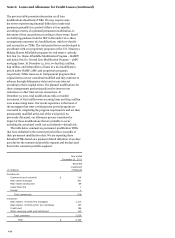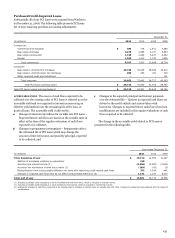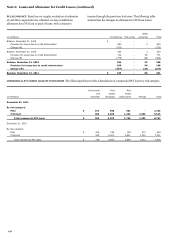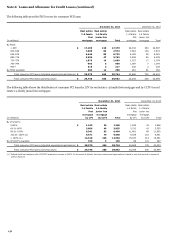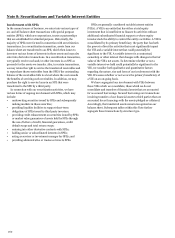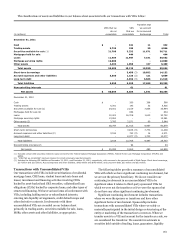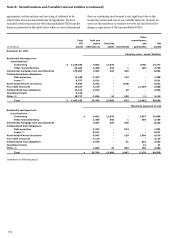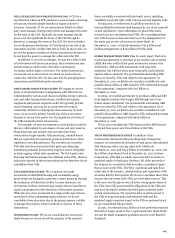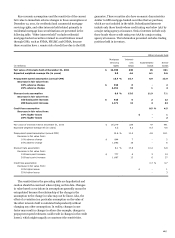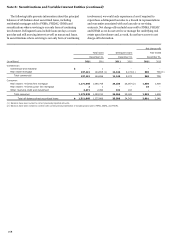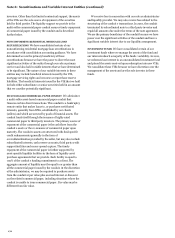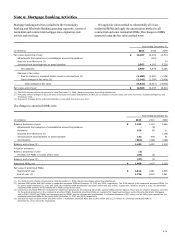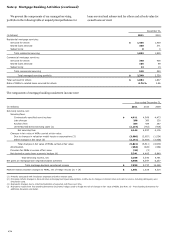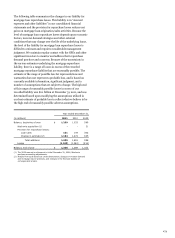Wells Fargo 2011 Annual Report Download - page 166
Download and view the complete annual report
Please find page 166 of the 2011 Wells Fargo annual report below. You can navigate through the pages in the report by either clicking on the pages listed below, or by using the keyword search tool below to find specific information within the annual report.Note 8: Securitizations and Variable Interest Entities (continued)
In the two preceding tables, “Total VIE assets” represents the
remaining principal balance of assets held by unconsolidated
VIEs using the most current information available. For VIEs that
obtain exposure to assets synthetically through derivative
instruments, the remaining notional amount of the derivative is
included in the asset balance. “Carrying value” is the amount in
our consolidated balance sheet related to our involvement with
the unconsolidated VIEs. “Maximum exposure to loss” from our
involvement with off-balance sheet entities, which is a required
disclosure under GAAP, is determined as the carrying value of
our involvement with off-balance sheet (unconsolidated) VIEs
plus the remaining undrawn liquidity and lending commitments,
the notional amount of net written derivative contracts, and
generally the notional amount of, or stressed loss estimate for,
other commitments and guarantees. It represents estimated loss
that would be incurred under severe, hypothetical
circumstances, for which we believe the possibility is extremely
remote, such as where the value of our interests and any
associated collateral declines to zero, without any consideration
of recovery or offset from any economic hedges. Accordingly,
this required disclosure is not an indication of expected loss.
RESIDENTIAL MORTGAGE LOANS
Residential mortgage loan
securitizations are financed through the issuance of fixed- or
floating-rate-asset-backed-securities, which are collateralized by
the loans transferred to a VIE. We typically transfer loans we
originated to these VIEs, account for the transfers as sales, retain
the right to service the loans and may hold other beneficial
interests issued by the VIEs. We also may be exposed to limited
liability related to recourse agreements and repurchase
agreements we make to our issuers and purchasers, which are
included in other commitments and guarantees. In certain
instances, we may service residential mortgage loan
securitizations structured by third parties whose loans we did
not originate or transfer. Our residential mortgage loan
securitizations consist of conforming and nonconforming
securitizations.
Conforming residential mortgage loan securitizations are
those that are guaranteed by GSEs, including GNMA. We do not
consolidate our conforming residential mortgage loan
securitizations because we do not have power over the VIEs.
The loans sold to the VIEs in nonconforming residential
mortgage loan securitizations are those that do not qualify for a
GSE guarantee. We may hold variable interests issued by the
VIEs, primarily in the form of senior securities. We do not
consolidate the nonconforming residential mortgage loan
securitizations included in the table because we either do not
hold any variable interests, hold variable interests that we do not
consider potentially significant or are not the primary servicer
for a majority of the VIE assets.
Other commitments and guarantees include amounts related
to loans sold that we may be required to repurchase, or
otherwise indemnify or reimburse the investor or insurer for
losses incurred, due to material breach of contractual
representations and warranties. The maximum exposure to loss
for material breach of contractual representations and
warranties represents a stressed case estimate we utilize for
determining stressed case regulatory capital needs and is
considered to be a remote scenario.
COMMERCIAL MORTGAGE LOAN SECURITIZATIONS
Commercial mortgage loan securitizations are financed through
the issuance of fixed- or floating-rate-asset-backed-securities,
which are collateralized by the loans transferred to the VIE. In a
typical securitization, we may transfer loans we originate to
these VIEs, account for the transfers as sales, retain the right to
service the loans and may hold other beneficial interests issued
by the VIEs. In certain instances, we may service commercial
mortgage loan securitizations structured by third parties whose
loans we did not originate or transfer. We typically serve as
primary or master servicer of these VIEs. The primary or master
servicer in a commercial mortgage loan securitization typically
cannot make the most significant decisions impacting the
performance of the VIE and therefore does not have power over
the VIE. We do not consolidate the commercial mortgage loan
securitizations included in the disclosure because we either do
not have power or do not have a variable interest that could
potentially be significant to the VIE.
COLLATERALIZED DEBT OBLIGATIONS (CDOs)
A CDO is a
securitization where an SPE purchases a pool of assets consisting
of asset-backed securities and issues multiple tranches of equity
or notes to investors. In some transactions, a portion of the
assets are obtained synthetically through the use of derivatives
such as credit default swaps or total return swaps.
Prior to 2008, we engaged in the structuring of CDOs on
behalf of third party asset managers who would select and
manage the assets for the CDO. Typically, the asset manager has
some discretion to manage the sale of assets of, or derivatives
used by the CDO, which generally gives the asset manager the
power over the CDO. We have not structured these types of
transactions since the credit market disruption began in late
2007.
In addition to our role as arranger we may have other forms
of involvement with these transactions, including transactions
established prior to 2008. Such involvement may include acting
as liquidity provider, derivative counterparty, secondary market
maker or investor. For certain transactions, we may also act as
the collateral manager or servicer. We receive fees in connection
with our role as collateral manager or servicer.
We assess whether we are the primary beneficiary of CDOs
based on our role in the transaction in combination with the
variable interests we hold. Subsequently, we monitor our
ongoing involvement in these transactions to determine if the
nature of our involvement has changed. We are not the primary
beneficiary of these transactions in most cases because we do not
act as the collateral manager or servicer, which generally denotes
power. In cases where we are the collateral manager or servicer,
we are not the primary beneficiary because we do not hold
interests that could potentially be significant to the VIE.
In 2011, we incurred a $377 million loss on trading
derivatives related to certain CDOs. The loss was associated with
the resolution of a legacy Wachovia position that settled during
the year.
164


